Picture Pages: Was It a Catch?

There's been some question over the no-catch ruling on Virginia Tech's 3rd down overtime prayer to receiver/punter Danny Coale. The play was ruled a touchdown live but overturned on review.
The setup: On 3rd down and 5 from the Michigan 20 in the first possession of overtime, Virginia Tech QB Logan Thomas attempted to hit Coale on a corner route in the end zone. Coale had Michigan's coverage (by safety Woolfolk and cornerback Avery) beat to the outside but the ball was slightly overthrown. Coale dove for what would be a spectacular one-handed catch, bringing the ball in just as he, and it, hit the ground just inbounds. The side judge ruled it a touchdown, but on review it was overturned and ruled an incomplete pass because the receiver did not have control of the ball when the ball hit the ground.
when the ball hit the ground.
The rule: You can find it on Pages 72-73 of the NCAA rulebook (emphasis mine):
Incomplete Pass
ARTICLE 7. a. Any forward pass is incomplete if the ball is out of bounds by rule or if it touches the ground when not firmly controlled by a player. It also is incomplete when a player leaves his feet and receives the pass but first lands on or outside a boundary line, unless his progress has been stopped in the field of play or end zone (Rule 4-1-3-p) (A.R. 2-4-3-III and A.R. 7-3-7-I).
The argument: The debate centers on whether or not Coale had "firm control" of the ball when it touched the ground. If the ball never touches the ground it's a clear reception, but since in this case nobody is arguing that the ball didn't touch the ground, the standard we're debating is whether or not Coale had established this firm control before the ball touched turf. For that we will consult the video.
With the grit of 40 Ecksteins, two Welkers, and half a Dileo, Coale reaches out and gets a hand underneath the ball. This is not "firm" control.
Coale now brings the ball between his forearms. This too would not be confused for "firm possession." However at this point he has a chance, if he can bring the ball to his chest and get it crooked in his arm, to prevent the ball from hitting the hard thing that is rapidly rushing toward him very fast.
So big and flat and round, it needs a big wide sounding name like 'Ow', 'Ownge', 'Round', 'Ground'! That's it! Ground! Ha! I wonder if it'll be friends with me?
Here is the money shot (clickening embiggens). Coale's elbow has hit the turf (just inbounds) but the ball is still between his forearms, not in his hands. It is hard to tell but the ball has now hit the ground as well, a nanosecond after the elbow.
Video:
The announcers were focusing on the elbow but the question is still one of whether the ball was firmly controlled by the player before it hit the ground.
A good test of this "firm control" (this is a sanity check not the final arbiter) is whether the ball moved when it hit the ground. It stands to reason that if the receiver had firm control of the ball when it came in contact with the ground it won't move that much.
If you recall, this is what doomed Junior Hemingway's TD catch attempt while down 8 in the closing seconds of the Iowa game. Hemingway actually managed to get two hands under the ball and secure it against his chest and arm a moment before coming down atop it. The "firm control" test in that case seemed to have been passed, but the catch was ruled incomplete because the reviewers saw the ball move in his possession after it hit the ground.
As you can see in the screenshots below, at the zero moment (when a part of the body made the player down) Coale's level of possession is way less than Hemingway's.
What controversially damned Hemingway was that after this the ball rotated about 90 degrees after the nose of the ball hit the ground, or so it was supposed since Hemingway's body blocked most of that. With Coale however the movement after contact with ground was pretty clear.
The ball is between Coale's forearms and possession only becomes firm long after the ball has impacted the ground. This I believe is what the review officials saw.
Incomplete! Time to bring in the 3rd string VT kicker who has been 4/4 today for an easy field g…oh snap!
But it's too close to call/not enough evidence to overturn! If someone is saying this to you they are confusing a Law & Order episode for reality. They have conceded that "incomplete" is the correct call, and are essentially complaining that it should have been ruled incorrectly because of a technicality in the literal meaning of the review rule. You cannot complain about calls the refs get right; that's not how complaining works. If you think the video is "inconclusive" you are conceding the call could have gone equally either way and saying it should be one or the other makes as much sense as whining that a flip of the coin should have been heads.
January 4th, 2012 at 2:49 PM ^
+10,000 to you (not that you need them).
January 4th, 2012 at 3:33 PM ^
(One from Fritz Crisler.) And another from me makes 10,002.
January 4th, 2012 at 3:36 PM ^
... the four-frame animation close up, I must eat my previous words that it was a catch.
The ground clearly aided the receiver gain possession. No catch.
Helluva good try by the receiver, though!
January 4th, 2012 at 3:46 PM ^
is that the referee's post-replay recitation of the rule as cited by Seth, was spot-on. The correct ruling, for the correct reason, correctly citing the correct rule in the process. Had we been burned on this one, as well as Hemingway's end-line catch versus Iowa, it would have caused some severe chapping. Might have left a mark. I still think that there is a good case to be made, that Hemingway's ball was a catch and Coale's was not, applying the same rule equally.
January 4th, 2012 at 6:36 PM ^
The slow mo really shows how the ground aided the catch. He has the ball pinned between his forearms, but he has not caught it, and as the nose of the ball hit the ground it moves the ball noticeably into his chest.
<br>
<br>The ball even drags along the ground as he tries to control it. It is a great effort, but its an incomplete pass. I dont think its even that hard a call. I was in the Dome last night. In stadium we could see on replays the ground aided the catch. The replay ref got it correct.
<br>
<br>
<br>
January 4th, 2012 at 2:57 PM ^
not matter, because Denard would taken off for a 25 yard touchdown on Michigan's OT possession, and then Hoke would have pointed at Fitz telling him to take the ball and hammer it in on the two point conversion resulting in a thunderous Michigan win, but I still say catch, catch today, catch tomorrow, catch forever. I say this because I think instant replay has had a very disproportionate effect on the complete v. incomplete pass as opposed to any ofher kind of play. I think the standard for a "completed" pass has become to high, almost leading to the impossibility of actually "catching" a ball while in close proximity to the ground. I think that the Coale play was as much a catch as Calvin Johnson v. the Bears last year or Junior v. Iowa this year. If the ball winds up in the receivers hands without any referee seeing it come out and the video does not provide clear evidence that it was trapped, it should be ruled a completed pass.
January 4th, 2012 at 3:12 PM ^
I kind of agree with what you're saying, but I think the video provides clear evidence it was trapped. The nose of the ball hits the ground and then shifts into a more secure position between the receiver's arms. Is that not trapped?
January 4th, 2012 at 3:42 PM ^
January 4th, 2012 at 2:52 PM ^
was not a catch + our kicker likes brunettes on the beach = tremendous!
January 4th, 2012 at 2:54 PM ^
Brilliant, detailed and conclusive. Well done.
January 4th, 2012 at 2:55 PM ^
Yuu can clearly see the ball hitting the ground while at the same time the receiver has only one hand on the ball. He clearly did not have control - the ground helped keep the ball right there for his left hand to wrap.
January 4th, 2012 at 2:57 PM ^
"that's not how complaining works"
i like that line.
January 4th, 2012 at 2:59 PM ^
I think that the Coale play was as much a catch as Calvin Johnson v. the Bears last year or Junior v. Iowa this year. If the ball winds up in the receivers hands without any referee seeing it come out and the video does not provide clear evidence that it was trapped, it should be ruled a completed pass.
I agree. And when they change the rules, I'll high-five you. But that's not what the rule says or how it's enforced.
January 4th, 2012 at 3:07 PM ^
I would have no problem with a rule that makes a play exactly like Coale's a catch, but that's not the rule right now. The refs can't go by anything else.
January 4th, 2012 at 3:08 PM ^
I doubt the rule has changed since instant replay was installed, but the number of angles, 3D, HD, 360 shots, all of these different kinds of analysis have completely changed the way it is enforced, thereby basically changing the definition to an unascertainable degree of "completion." You can't find a catch like that where a player has 100% control of the football. If you are going to call it like that, rhe rule should say "No portion of the ball can be touching the ground." That is how it is called right now.
January 4th, 2012 at 3:20 PM ^
...is that it's very hard to catch a football and control it as it hits the ground (especially if you're hitting the ground at the same time). There were probably a lot of non-catches ruled as catches in the past when replay didn't work as well or didn't exist.
January 4th, 2012 at 3:00 PM ^
Even I was confused on the rule, per se, but your analysis ends all doubt for me.
January 4th, 2012 at 3:00 PM ^
Almost got me in trouble in front of my class laughing so loudly.
January 4th, 2012 at 3:04 PM ^
It is crystal clear with that video. The win feels even better now!
January 4th, 2012 at 3:04 PM ^
The super slow-mo view from the opposite end zone finally seals the deal for me. Muchas gracias.
January 4th, 2012 at 3:06 PM ^
I agree with non-catch analysis, but your last point is not correct. The standard is "indisputable video evidence" after a call on the field is made. In other words, two parts: (1) What was the call on the field? (2) The call on the field stands unless there is indisputable video evidence to the contrary. The standard is not "was the call on the field correct?" It's not enough for the call to be incorrect, it has to be indisputable and there has to be video evidence. Rules have to have literal interpretations--that's why they are there in the first place.
January 4th, 2012 at 3:40 PM ^
I was about to post the exact same point. Was it indisputably not a catch? Apparently the refs thought so after review, and I'm really glad they did, but... not so sure. Although the last animated gif makes a very strong argument that the refs got it right.
Of course, I think that it was about as good a catch as the called-back INT that VT had in the third quarter(?), and if that one wasn't good enough, then this one wasn't good enough either, so at least they were consistent.
January 4th, 2012 at 3:45 PM ^
As a practical matter, you're going to go nuts if you actually bank on rules being enforced literally in sporting events. We all know that there's holding on every play, just like there's traveling on every possession in the NBA. By now, replay has been around long enough that we all know "indisputable video evidence" means something less than its literal meaning when applied to replay reviews. It's true that this leads to some degree of ambiguity - what is this particular crew's standard of sufficiency for overturning a call? - but that's the way it is.
January 4th, 2012 at 3:52 PM ^
That standard is misinterpreted to be a nod toward "let the refs referee." What "indisputable evidence" means is you have to see something in the video that is evidenciary and indisputable, e.g. the ball not being between Coale's forearms and moving a lot after it hits the ground.
"Indisputable evidence" is fine as a good standard for the refs. But when you argue it as a fan, what you're saying is "I know the call was botched, but only the most egregiously botched calls should be overturned." That reasoning puts the sanctity of the original call over what you saw happen on the video. You're shifting the definition of a "catch" from what we can all agree on (possession before the ball hits the ground) to a moving standard of how obvious it needs to be on review before the bad call is reversed.
The rule is there to make sure they can't reverse a call that they can't see. In this case they could see it, you can see it above, and therefore we can all agree that it happened unless we're Internet Hokie fans or haters. The reviewer, by overturning the call, tacitly said that this one met the "Indisputable Evidence" standard. A position that the standard for "indisputable" should be higher regardless of what happened on the field is putting the officiating ahead of the play on the field, which is the opposite of the goal of having review.
January 4th, 2012 at 5:29 PM ^
You're confusing "indisputable" with "uncontroversial" - which is facially absurd because generally calls don't need to get reviewed if they're obvious.
<br>
<br>There is indisputable video evidence that the ball hit the ground and moved when it did so. Their is great video and the replay official has everything he needed to make the call. The only controversy is over whether the receiver had "firm control". But that rule is by nature subjective - two referees could reasonably disagree on the definition of firm control. We're not arguing about the facts of the video, we're arguing over how much a ball needs to move upon hitting the ground to be considered uncontrolled.
<br>
<br>But note that the video is still "indisputable" - it shows exactly what happened. The call is close, subjective, and therefore controversial, but the video was good enough that the replay official was within his rights to overturn.
January 4th, 2012 at 3:07 PM ^
Back. And to the left.
January 4th, 2012 at 3:07 PM ^
Armando Allen was out of bounds. LOL, ND.
January 4th, 2012 at 4:32 PM ^
Hope you enjoyed St. Louis, UNO
January 4th, 2012 at 3:08 PM ^
in that, someone could honestly not know whether he had possession or not, rather than "conceding" that it was incomplete. And if it truly could have gone either way, it should default to the call on the field, which was, as we know, that he caught it. That's more than just a technicality (as someone has now beaten me to above).
HOWEVER, this is quality work and I will now feel less "bad" about winning in this manner, as I do now conclusively believe that it was not a catch. Thanks!
January 4th, 2012 at 3:08 PM ^
Before reading this I kept biting my tongue thinking that we got away with a call. I'm convinced otherwise now.
January 4th, 2012 at 3:10 PM ^
I thought it wasn't a catch because he landed out of bounds. Which brings up the question, what do we mean by "landed?" Say for example, if a player's heel lands in bounds first but as he continues the motion, the rest of his foot lands out of bounds. I would say that is a catch out of bounds. I think the same principle applies here. The first part of his body that lands is his arm and as he continues the motion that body part completes landing by hitting out of bounds. Thus, no catch.
I also noticed that the ball rotated, back and to the left, indicating that there was a 2nd ground.
[EDIT: beaten on the "back and to the left" by Scarn by 1 minute]
January 4th, 2012 at 3:25 PM ^
vs Penn State 2005 (IIRC) disagrees
January 4th, 2012 at 3:27 PM ^
I'm pretty sure that Jason Avant caught a sideline pass against Penn State back in 2005 where his toes came down in bounds but his heels continued to come down out of bounds. It was ruled a catch because his toes touched first.
Michigan continued the drive and Manningham caught the winning TD pass with :00 left on the clock.
Maybe somebody has better recollection (or a picture of this catch). Penn Staters still complain about it.
January 4th, 2012 at 3:43 PM ^
Trying to attach link to Avant catch...
http://www.youtube.com/watch?v=2wwbBMRkJ5I&feature=player_detailpage#t=4s
Apparently there was a rule change between 2005 and 2010 that may alter the current policy on this type of play. The catch was "good" at the time.
The OFFICIAL 2005 NCAA FOOTBALL RULE BOOK says this is a catch.
"To catch, intercept or recover a ball, a player who leaves his feet to make
a catch, interception or recovery must have the ball in his possession
when he first returns to the ground inbounds with any part of his body"
January 4th, 2012 at 4:26 PM ^
To me, it wasn't clear that his heal actually touched the ground. He lifted it back up pretty quick.
January 4th, 2012 at 6:46 PM ^
It looks on the replay as if the ball is touching the sideline by the time it can be said to be secured, as is the part of his arm attached to the elbow that landed in the endzone.
January 4th, 2012 at 3:10 PM ^
are still psychotic over this call today. They need medication badly.
January 4th, 2012 at 3:11 PM ^
Wouldn't the ball move anyway b/c his body was moving? (Don't want to get all Einstein on you here)
Feel bad for the kid, as he made the big fake punt miscue...this was his shot to make it up
Good game by 2 good teams...how about a home and home? Or a neutral site?
January 4th, 2012 at 3:17 PM ^
What's conclusive to me, though, is that the ball moves incongruently with his body/arms. It is on it's own path, which means he doesn't have firm control.
January 4th, 2012 at 3:45 PM ^
Yes! Exactly. Especially from the back angle, you can definitely see that the ball continued to move through his forearms before he hit the ground. It was moving slowly, but it clearly was still moving, and it didn't stop before it hit the ground. That's why he didn't have "firm control" (and why the ball moved so much in his arms once it hit the ground). If he had been upright and in the middle of the field he almost certainly would've had time to pull the ball into his chest and secure it, but he never did so during the actual catch. To me, this was a close call (and probably impossible to make correctly without replay), but the officials clearly got it right after the review.
A lot of the criticism seems to be of the variety that close calls, by definition, can never be overturned, but I think that's a misinterpretation of the rule. "Indisputable video evidence" doesn't mean "the officials clearly botched that call;" it means "I can clearly see that the call on the field was incorrect." That can apply to close calls as well as ridiculous ones.
January 4th, 2012 at 3:20 PM ^
It should move, but I'd firmly grasped it wouldn't move relative to the body. In the GIF, you clearly see the angle of the ball move more toward a horizontal position as it hits the ground, while his back does not change at all and push the ball. So the ball moves relative to his body as well.
January 4th, 2012 at 3:12 PM ^
Saw this pic circulating recently on Facebook. I think this is one of the best examples why still shots should never be used in lieu of video. I'm not even going to begin refuting this image because, well, it's just too obvious. And as far as I can tell, a real live Hokie fan posted this as a legit argument for why it should have been a TD. Really.

January 4th, 2012 at 3:40 PM ^
So if you land out of bounds, but BOUNCE, and then drag a foot inbounds, the catch is good. Got it.
Not arguing the out ouf bounds vs. control, but by that poin his shoulders had already slid out of bounds before bouncing. This picture as proof of catch is absurd.
January 4th, 2012 at 3:13 PM ^
Excellent post. The on-field call probably could have gone either way so I don't blame the refs for calling it a touchdown, but the video replay seems pretty conclusive. In any case, you've made it abundantly clear that VaTech fans bitching about this don't have a leg to stand on.
January 4th, 2012 at 3:13 PM ^
If the ball is between his forearms, he doesn't have possession. If the ball moved there, he clearly did not have possession to begin with, and having the ball between his forearms won't make it so.
January 4th, 2012 at 3:23 PM ^
It would still have been reviewed correct?
Its not like the pros where only scoring plays are reviewed?
January 4th, 2012 at 3:28 PM ^
Don't quote me on this because it may just be the Big Ten's system but to my knowledge college football doesn't have so many standards about what can and can't be reviewed except judgment calls (e.g. pass interference and holding).
The system is best described as a guy upstairs with a DVR who sometimes says "waitaminute I gotta watch that again."
January 5th, 2012 at 12:55 PM ^
In college, every play can be reviewed: while there are some things that can't be looked at, possession/catch things are definitely reviewable, and the booth can call for that after any play.
In the NFL, the booth can only review plays inside two minutes and plays on which points are scored. (I expect that'll change in the offseason to include plays on which points would have been scored if the call were reversed.)
Of course in both cases, a coach with a challenge remaining could ask for a review on a catch like that.
January 6th, 2012 at 6:43 AM ^
...even in the NFL this would have been reviewed, as they are now automatically reviewing all touchdowns.
Edit - I shoud read more carefully - you already mentioned "scoring plays."
January 4th, 2012 at 3:28 PM ^
WE WIN! No CATCH! Take that Hokies!
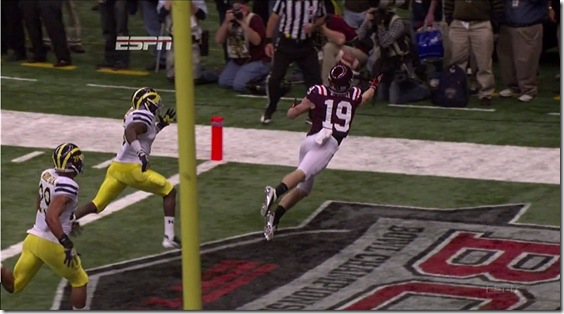
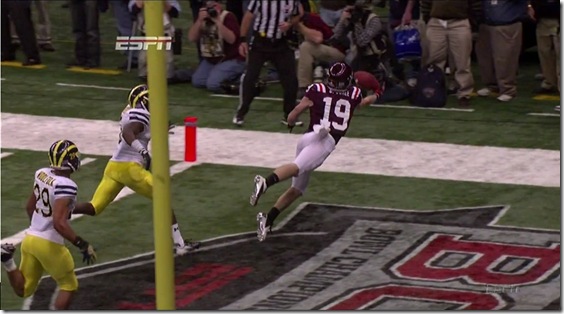
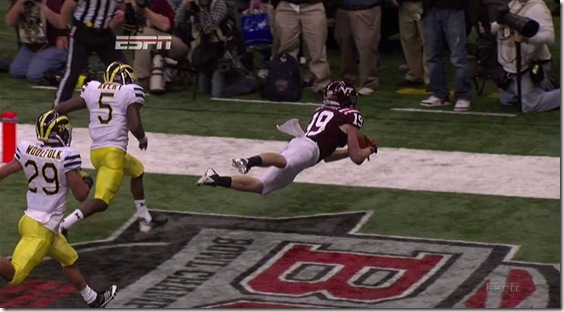
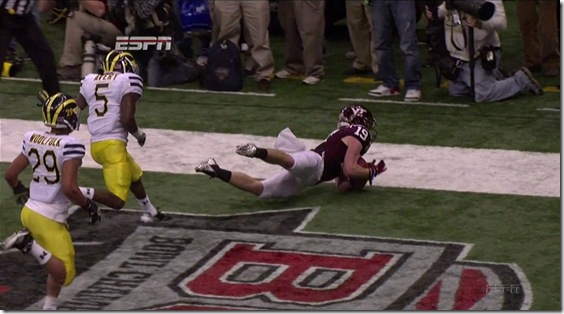
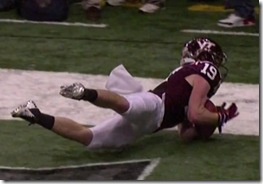
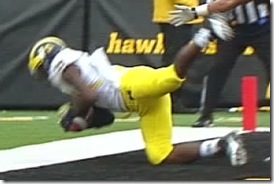

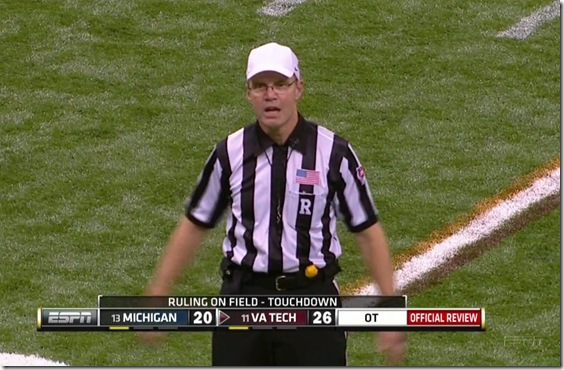
Comments